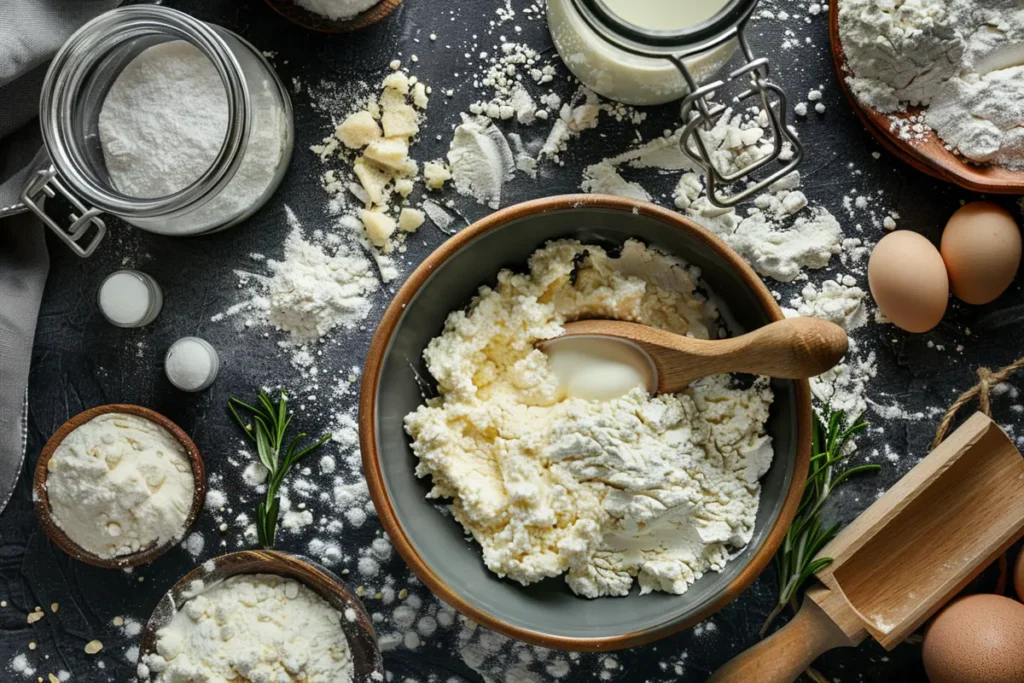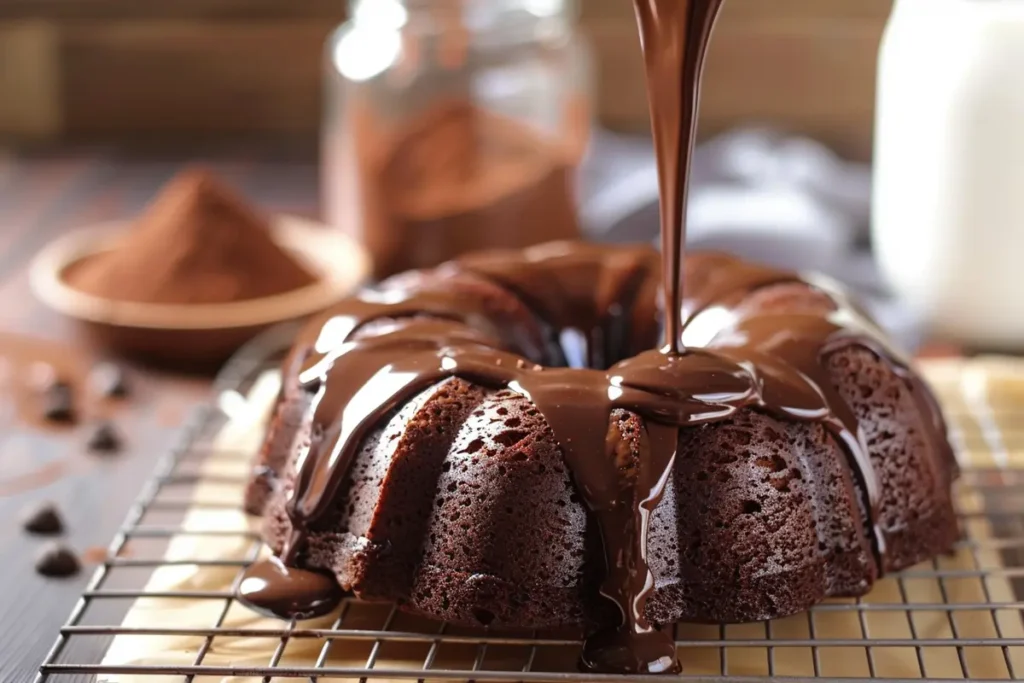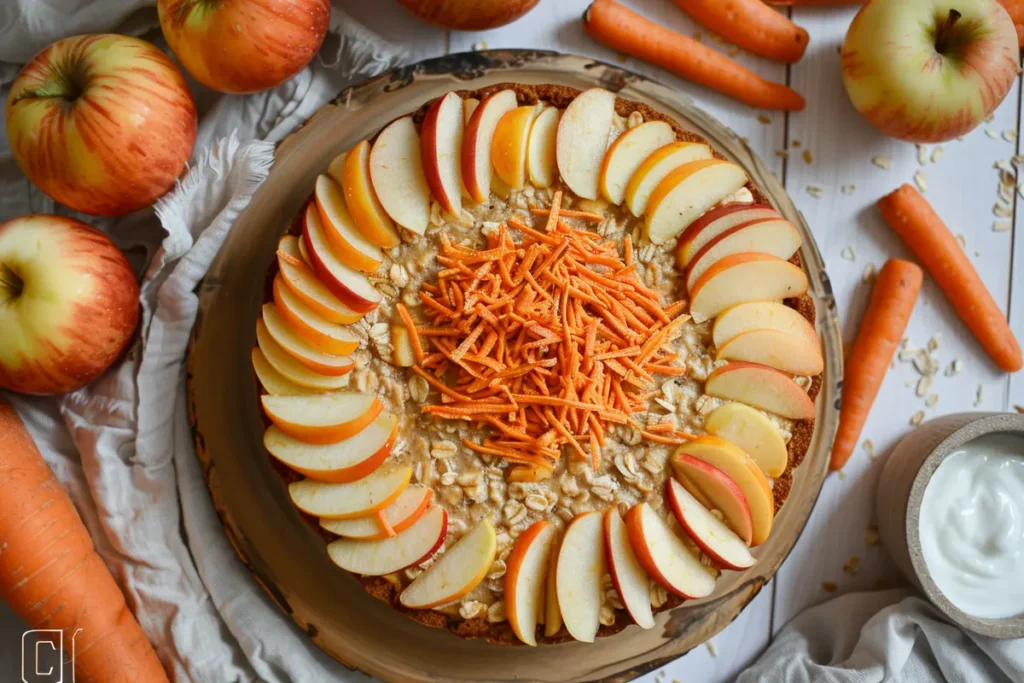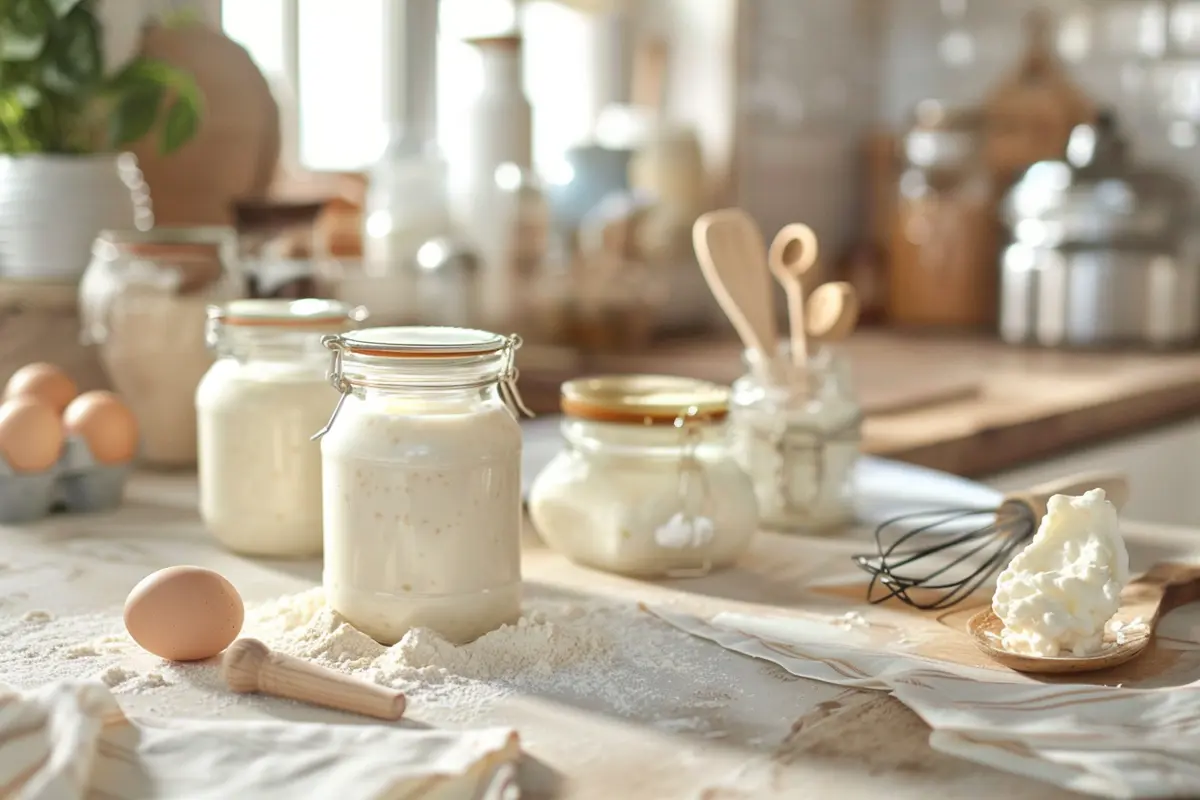Substituting ingredients in baking can often feel like a high-stakes gamble. The question, “Can I use kefir instead of yogurt in cake?”, is one that many bakers ask, especially when experimenting with new recipes or trying to make use of what’s on hand. Both kefir and yogurt are fermented dairy products, but they bring unique properties to baking. This article will delve into the differences between these two ingredients, how to substitute them effectively, and what impact kefir has on the texture, flavor, and nutritional value of cakes. By the end, you’ll feel confident swapping yogurt for kefir in your favorite recipes.
Understanding Kefir and Yogurt
Nutritional Profiles of Kefir and Yogurt
Both kefir and yogurt are nutritional powerhouses, but they’re not identical. Yogurt is a rich source of protein and calcium, often fortified with vitamin D to support bone health. It contains probiotics that aid digestion and promote a healthy gut.
Kefir, on the other hand, offers a broader spectrum of probiotics due to its fermentation process, which involves a symbiotic culture of bacteria and yeast (SCOBY). It’s lower in lactose than yogurt, making it easier to digest for those with sensitivities. Additionally, kefir provides a range of B vitamins and magnesium, supporting energy production and overall wellness.
Fermentation Processes: Key Differences
The fermentation process sets kefir and yogurt apart. Yogurt is made by introducing specific bacterial strains—Lactobacillus bulgaricus and Streptococcus thermophilus—to milk, creating a thick, creamy texture. It requires controlled temperatures to achieve the desired consistency.
Kefir’s fermentation is more dynamic. Using kefir grains, a mix of bacteria and yeast ferments the milk at room temperature. The result is a tangy, slightly fizzy drink with a thinner consistency than yogurt. This effervescence comes from the carbon dioxide produced during fermentation, giving kefir its unique characteristics.
Why These Differences Matter in Baking
These differences in composition and fermentation directly influence how kefir and yogurt behave in recipes. Yogurt’s thickness makes it ideal for adding structure and moisture to batters, while kefir’s acidity and liquid consistency can act as a natural tenderizer and leavening agent. When substituting kefir for yogurt, understanding these nuances is key to maintaining balance in your recipe.
Baking with Yogurt – A Standard Approach
The Role of Yogurt in Cake Recipes
Yogurt is a popular choice in cake recipes for several reasons, and it’s no surprise why. Its creamy texture and mild tang bring a delightful balance to both flavor and structure. Here’s how yogurt shines in baking:
- Moisture Retention: Yogurt adds a rich, velvety moisture to cakes, ensuring they don’t dry out.
- Tangy Flavor Boost: The slight acidity enhances the sweetness of cakes, creating a well-rounded flavor profile.
- Natural Leavening: Its acidity reacts with baking soda or powder, producing a light and airy texture.
- Versatility: Yogurt can adapt to a wide range of recipes, from dense pound cakes to fluffy sponges.
Common Types of Yogurt Used in Baking
Not all yogurts are created equal, and the type you choose can impact your cake’s final outcome:
- Plain Yogurt: The go-to option for most recipes, offering a neutral base without added sugars.
- Greek Yogurt: Thick and protein-rich, ideal for denser cakes like bundts or loaf cakes.
- Low-Fat Yogurt: Lighter on calories, but may require additional fat in the recipe to maintain moisture.
Pro Tip: Stick to unsweetened varieties to control the sweetness of your batter. The goal is to let the cake’s primary flavors—be it vanilla, chocolate, or fruit—shine without interference.
Substituting Kefir for Yogurt in Cake
Consistency and Texture Considerations

When swapping yogurt with kefir, the first thing to note is the difference in consistency. Kefir is thinner, more like a pourable drink, whereas yogurt has a thicker, spoonable texture. This change can affect how the batter behaves:
- Thinner Batter: Substituting kefir may make the batter runnier, which can lead to uneven baking. To counter this, reduce other liquid ingredients like milk or water slightly.
- Tender Crumb: Thanks to its acidity, kefir enhances the softness of cakes, making them tender and melt-in-your-mouth delicious.
Flavor Implications
The tanginess of kefir is slightly more pronounced than yogurt, which can subtly alter the cake’s flavor profile. While this tang may complement citrus or chocolate flavors, it might overpower delicate flavors like vanilla.
How to Adjust: For subtler flavors, balance kefir’s tang by adding a touch more sugar or a splash of vanilla extract. This keeps the flavor harmonious without losing kefir’s unique charm.
Adjusting Measurements and Ratios
To ensure a smooth substitution, follow these guidelines:
- 1:1 Ratio: Use an equal amount of kefir as the recipe calls for yogurt.
- Thickness Adjustments: If the batter feels too thin, add 1–2 tablespoons of flour until it reaches the desired consistency.
- Sweetness and Tang Balance: Taste your batter and make small tweaks to sugar or other flavoring agents as needed.
By understanding these nuances, you can confidently incorporate kefir into any yogurt-based cake recipe.
Benefits of Using Kefir in Baking
Enhanced Moisture and Crumb Structure
Kefir has a unique ability to retain moisture in baked goods, giving cakes a soft and luscious crumb. Its liquid consistency helps hydrate the batter more evenly, ensuring that every slice stays moist for days.
Additionally, kefir’s acidity tenderizes the gluten in flour, making the cake’s texture lighter and more delicate. This is particularly beneficial for recipes that use whole grain or gluten-free flours, which can sometimes result in denser cakes.
Probiotic Advantages
One of kefir’s standout features is its probiotic content, which promotes gut health and supports digestion. While the high heat of baking may reduce the number of live probiotics, many of kefir’s enzymes, vitamins, and minerals remain intact.
This means that cakes baked with kefir are not just indulgent treats—they’re also a step toward more health-conscious baking. For those looking to combine flavor and wellness, kefir is a win-win ingredient.
For a deeper dive into kefir’s unique properties, explore our article on What does kefir do in baking?.
Potential Challenges and Solutions
Managing Batter Consistency
One of the common issues when substituting kefir for yogurt is managing the batter’s consistency. Kefir’s thinner texture can lead to a runny batter, which may affect how the cake bakes.
Solution: Adjust the ratio of liquid and dry ingredients. Reduce other liquids like milk or water, or add extra flour by the tablespoon until the batter thickens to the desired consistency.
Flavor Balance Adjustments
Kefir’s tangy flavor is more pronounced than yogurt’s, which can sometimes overwhelm subtler cake flavors like vanilla or almond.
Solution: Balance the tang by adding a small amount of extra sugar or sweetener. You can also increase the quantity of complementary flavors like vanilla extract, cinnamon, or citrus zest to create harmony.
Preventing Overbrowning
Because kefir enhances browning during baking due to its natural sugars, cakes might brown faster than expected.
Solution: Keep an eye on the cake as it bakes, and cover it loosely with foil if the top starts to brown too quickly. This ensures the cake bakes evenly without becoming overly dark.
With these tips, you can troubleshoot and refine your recipes to ensure that every kefir-substituted cake turns out beautifully.
Practical Tips for Successful Substitution
Selecting the Right Type of Kefir
Not all kefir is created equal. Depending on the recipe and your dietary preferences, the type of kefir you choose can make a significant difference:
- Plain Kefir: Best for maintaining control over sweetness and flavor in cakes. Avoid flavored or sweetened kefir unless the flavor complements the recipe.
- Full-Fat Kefir: Adds richness and enhances the moistness of dense cakes like pound cakes or bundt cakes.
- Non-Dairy Kefir: Perfect for vegan or lactose-intolerant bakers. Coconut milk kefir or almond milk kefir works well in recipes that call for yogurt.
If you’re ready to experiment, try substituting kefir in our kefir sheet cake recipe. It’s an easy way to see the difference
Incorporating Additional Ingredients
To optimize the performance of kefir in baking, consider pairing it with ingredients that complement its properties:
- Leavening Agents: Combine kefir with baking soda for a natural leavening effect. Its acidity reacts beautifully to create light, airy cakes.
- Sweeteners: A touch of honey, maple syrup, or extra sugar balances kefir’s tanginess, particularly in desserts like vanilla or lemon cakes.
- Spices and Zests: Cinnamon, nutmeg, or citrus zest add layers of flavor that harmonize with kefir’s tartness.
Baking Time and Temperature Adjustments
Because kefir increases moisture and enhances browning, you may need to tweak your baking process slightly:
- Lower Temperature: Reduce the baking temperature by 25°F (approximately 15°C) to prevent overbrowning while ensuring even cooking.
- Watch the Clock: Start checking for doneness a few minutes earlier than the recipe suggests. Use a toothpick to test if the center is cooked through.
Expert Opinions and Case Studies
Professional Bakers’ Experiences
Experienced bakers often highlight the versatility of kefir as a substitute for yogurt:
- Chef Jane Thompson, a baking instructor, swears by kefir for achieving an ultra-moist crumb in her chocolate and carrot cakes. She notes, “Kefir’s tanginess not only enhances flavor but also keeps cakes fresh longer.”
- Baking Blog Author Amanda Green recommends kefir for recipes requiring a tender texture, like sponge cakes and coffee cakes, especially when using alternative flours.
Home Bakers’ Testimonials
Home bakers also rave about the flexibility and ease of using kefir:
- “I was out of yogurt one day and decided to try kefir in my lemon cake. It turned out even better than usual—so soft and flavorful!” says Rachel, a hobby baker.
- John, an avid bread baker, shares, “Kefir transformed my cinnamon rolls into pillowy perfection. The difference was night and day!”
Their stories reinforce that kefir is not only a viable substitute for yogurt but often an upgrade.
Popular Cake Recipes Using Kefir
Chocolate and Vanilla Kefir Cake

This recipe highlights how kefir enhances the flavors of classic chocolate and vanilla cakes:
- Chocolate Cake: The tangy notes of kefir amplify the richness of cocoa, creating a deep, velvety chocolate cake. Simply substitute kefir for yogurt in your favorite recipe, using the 1:1 ratio and balancing the batter with a touch of extra sugar or flour if needed.
- Vanilla Cake: Kefir’s mild acidity balances the sweetness of vanilla, resulting in a fragrant and tender crumb. Add vanilla bean paste for an even more luxurious flavor.
Oat and Kefir Cake with Carrots and Apples

For a wholesome treat, try this oat-based cake that combines the earthy sweetness of carrots and apples with the tanginess of kefir:
- Moisture Boost: Kefir keeps the oats soft and the overall crumb moist.
- Flavor Harmony: The natural sweetness of apples and carrots complements the tang of kefir, while spices like cinnamon and nutmeg add warmth.
- Healthy Twist: The probiotics and nutrients in kefir make this dessert feel indulgent yet nourishing.
Frequently Asked Questions
Can I use kefir instead of yogurt in all baking recipes?
Yes, kefir can replace yogurt in most baking recipes, especially cakes. Its tangy flavor and acidity work well in recipes that require yogurt. However, adjustments to liquid ratios or sweetness may be needed based on the recipe.
Will kefir change the taste of my cake?
Kefir has a slightly stronger tang than yogurt, which may subtly alter the cake’s flavor. In most cases, this change enhances the overall taste, especially in recipes with chocolate, citrus, or spices.
Do I need to adjust other ingredients when using kefir?
Kefir’s thinner consistency might require reducing other liquids or adding a bit of flour to maintain the desired batter texture. Always taste and tweak sweetness if necessary.
Is kefir suitable for vegan baking?
Yes, non-dairy kefir made from almond or coconut milk is an excellent option for vegan baking. It retains the tanginess and leavening properties of traditional kefir.
Conclusion
Substituting kefir instead of yogurt in cake is more than just a quick fix—it’s an upgrade. From its ability to create moist, tender crumbs to its probiotic and nutritional benefits, kefir is a baking powerhouse.
While there are slight differences in consistency and tanginess, with a few adjustments, kefir can elevate your cakes to a new level. Its versatility extends beyond cakes to muffins, breads, and even pancakes, proving it’s a worthy addition to any baker’s toolkit.
So, the next time you find yourself without yogurt or want to experiment, reach for a bottle of kefir. Your taste buds—and your gut—will thank you!

